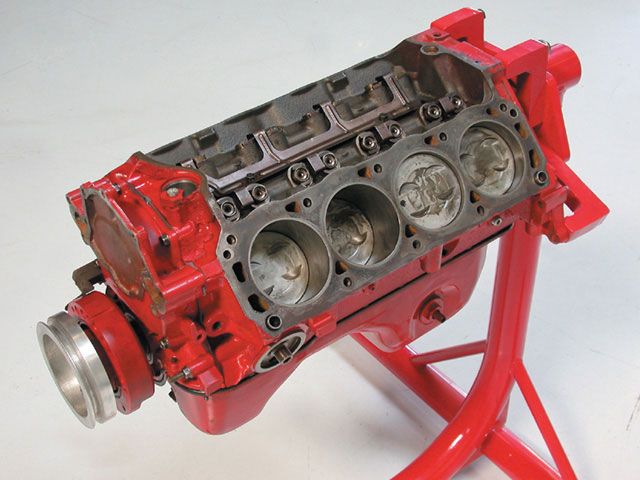
If we claimed we could make 400 hp with a stock Ford 302 short-block and the stock factory hydraulic-roller cam, you'd probably say, "No big deal, they're probably using nitrous." What if we said we could do it without nitrous or any other kind of power-adder--totally naturally aspirated, and the only things we'll change are the heads, headers, and rocker arms? Everything else--pistons, rods, cam, oiling system, and so on remains totally stock. We hope you'd be impressed, because we certainly were.
The key to this remarkable achievement is simple: one awesome set of cylinder heads. Heads so good in fact, that they are worth about 100 hp over a set of stock 5.0L Mustang heads on their own. You read that right--100 horsepower. Over the years, we've tested many great cylinder heads and have become used to gains of 50, 75, or more horsepower compared to low-performance factory castings, but the Air Flow Research 165cc smog-legal heads we tested on this small-block Ford may take the prize for the best bolt-on performance gain we've ever seen from a set of heads.
The foundation for the test was a bone-stock 5.0L H.O. engine taken from a '91 Mustang. As delivered, 5.0 engines of this vintage had forged-aluminum pistons, a hydraulic-roller camshaft (see spec chart), a double-roller timing set, and stamped 1.6:1 nonadjustable rocker arms. Rated static compression runs around 9.0:1 with the stock cast-iron E7TE cylinder heads, which are equipped with puny 1.78/1.46-inch intake/exhaust valves and nominal 60cc chambers. With stock fuel-injection, this engine was factory rated at 225 hp at 4,200 rpm and 300 lb-ft of torque at 3,000.
Our test engine maintains most of those specs, with the only alterations being a quick bottle-brush hone to clean up the cylinder walls and a set of fresh rings and bearings. We baselined the freshened-up short-block with a pair of rebuilt but otherwise stock E7TE factory heads, the stock hydraulic-roller cam, stock tubular exhaust manifolds, and a Weiand Stealth dual-plane intake topped with a four-barrel carburetor. That combination developed 278 hp at 5,200 rpm and 315 lb-ft of torque at 4,100 on Westech Performance's SuperFlow 901 engine dyno.
With those numbers in hand, we made three changes in two steps: first, we bolted on a set of Air Flow Research's 50-state-legal 165cc aluminum cylinder heads. Equipped with 1.90/1.60-inch intake/exhaust valves, these heads are designed to clear the valve-relief notches in the stock forged-aluminum pistons without modification, making them an easy bolt-on. We opted to order the heads with provisions to accept the stock nonadjustable pedestal-style rocker-arm setup, which allowed us to test them with the stock stamped rockers. AFR also offers these heads set up with studs and guideplates for conventional roller rockers. We've seen these heads tested on other combinations and have been impressed with their performance, but this is the first time we've bolted a set of the 165s on such a stock engine. Rather than choke the heads with the stock exhaust manifolds, we stepped up to a pair of Doug's Headers stepped Tri-Y headers designed to fit a '60-'65 Ford Falcon, the car we eventually plan to swap this engine into. Previous testing has shown this design, which incorporates stepped 1-5/8-to-1-3/4-inch primary tubes, to be fully equal to, if not slightly better than, traditional four-into-one long-tube headers.
We bolted the AFR heads onto the short-block with a set of ARP head bolts and a new set of Fel-Pro head gaskets, and reinstalled the Weiand dual-plane along with a brand-new Road Demon Jr. 625-cfm carburetor (see sidebar). With 35 degrees of total ignition lead and 70 jets in the primary metering block, the little 302 produced a jaw-dropping 382 hp at 6,000 rpm and 368 lb-ft of torque at 4,200, a gain of 104 hp and 53 lb-ft solely from the heads and headers.
At this point, we briefly considered swapping the stock cam for a larger 'stick to see if we could crest the 400hp mark, but that would have been too obvious, not to mention a fair bit of work, and we were feeling lazy that day. Far simpler would be to swap on a set of higher-ratio adjustable roller rockers. The higher-ratio rockers offer the benefit of increasing effective lift and duration at the valves without compromising the inherent driveability of the mild stock cam. Comp Cams offers the perfect product for this application with its aluminum adjustable 1.7:1 roller rockers (PN 1054), which bolt onto the stock cylinder-head pedestals and allow easy valve adjustment with a pushrod-cup adjuster nut. We had the valve gear swapped in about 15 minutes (we didn't even have to change the pushrods), and pulled the handle on the dyno. Success! As expected, the higher-ratio rockers increased the area under the curve of the stock cam, pushing output to 405 hp at 6,200 rpm and 380 lb-ft of torque at 4,300, a gain of 23 hp and 12 lb-ft of torque.
To put this performance in context, consider that this relatively small engine is making 1.34 hp and 1.25 lb-ft of torque per cubic inch with a stock camshaft. An equivalent 350ci engine would need to make 470 hp and 437 lb-ft to equal this specific output, numbers that usually take good cylinder heads and a healthy cam. So these AFR heads really are just that good. The 302 also benefits from having a 4-inch bore, which maximizes the cylinder-head flow, and although the stock hydraulic-roller camshaft is small by performance standards, its lift and duration figures are pretty decent compared to a typical smog-era stocker.
The beauty of this combination is that you can take a very inexpensive stock engine, spend your money on a few good parts that really make power, and wind up with a truly kick-ass, driveable little engine without breaking the bank. Now just imagine all those parts bolted onto a 347 stroker with a big cam. Maybe next time.